Itsaso Hila: A living lake
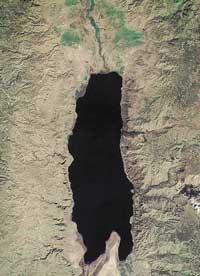
The healing of the Dead Sea is known since Roman times. According to legend, Marco Antonio conquered the lake and its surroundings to give it to Cleopatra, and since then his fame has only increased. Currently, the lake is surrounded by spas, hotels and health centers, and cosmetics with their salts are highly appreciated worldwide.
However, this treasure has been endangered by humans and it is increasingly difficult to preserve its special qualities. But first of all, let's see what makes the Dead Sea so special and precious.
The saltier water of the lower ibón
From the Turkish mountains of Taurus to the south of the Sinai peninsula, there is a rift of 1,000 km in length. The Rifta is a valley that is born in the place where two tectonic plates are being distributed. In a depression of the Rift is the lake known as the Dead Sea, on the border between Israel, Palestine and Jordan, in the middle of the Judea desert.
Its tectonic origin explains, in some way, that it is the lowest point of the sea level. -It is exactly 417 m, so the water that reaches it can not go anywhere else. The Jordan River is the most important river that reaches it: It is born in the Sea of Galilee and ends in the Dead Sea.
In addition, elbows are the main water sources of the lake. Canals are canals that only have water at certain times of the year, remaining dry throughout the rest of the year. However, on many occasions underground rivers also flow through the channels, giving rise to oases at points near the surface.

The water that emerges in Oasis has a great importance in the ecosystem of the area and in the water supply of the lake. In these places wetlands are created full of fresh and salt water and a rich flora and fauna develops.
In addition to these water sources, in the vicinity of the lake there are sources of sulphurous and thermal water. The water temperature of these sources ranges from 35-60 °C, with most of them being loaded with minerals. The mineral waters and salts of these sources greatly enrich the chemical composition of the lake.
The main protagonist of the Dead Sea is salt. Lake water is 10 times salty than ocean water: 340 grams of salt per liter of water. Salt is not a sodium chloride, but in the lake there is less sodium chloride than in the sea. Instead we find other salts, mainly chlorides (magnesium chlorides, sodium, potassium and calcium and bromine chlorides). When analyzing how such a high concentration of salts has occurred, we will see that it is a logical consequence of many special characteristics.
The lake is located in the desert of Judea, so the desert climate dominates this area. Between 25 and 50 mm/year of water fall per square meter and heat throughout the year: in winter the temperature does not drop from 20ºC and in summer it is not unusual to exceed 35ºC. Therefore, the evaporation rate of water is very high. It evaporates 25 mm of water a day, so all the rain that rains throughout the year evaporates in a couple of days.
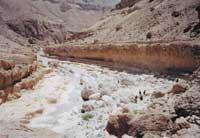
This strong evaporation is one of the main causes of the high saline concentration of water. In any case, it is logical to think that this evaporation would force the lake to remain dry long ago. But, according to the latest data, scientists know that the lake is at least 12,000 years old. How can such a large evaporation withstand the lake without drying?
Your answer should be sought in height or, rather, in the absence of height. As mentioned earlier, it is the lowest point of sea level, so all the water around it accumulates. All the rivers and underground streams end their way, so although the water flow is very variable according to the seasons, there is always some water source. This is why the lake may present such a high concentration of salts.
Such a high concentration of salts provides special characteristics to water. On the one hand, this water has a high density. Therefore, the person who tries to dive into these waters, instead of swimming, floats.
Another effect of high salt concentration is weight. Salts make water very heavy, which affects the sediments at the bottom of the lake. Sediments, due to the weight to bear, tend to move to the shores of the lake. Therefore, every year the salt layer of the lake shore grows 3 mm.
Not living without salt
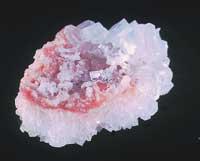
Such a concentration of salts makes it impossible to develop ecosystems similar to those of the lakes we know. Living beings arriving at the lake from the Jordan River, fish and insects, are doomed to die in it. But, although it may seem surprising, there are also living beings who can live in these extreme conditions. They are halophyll microorganisms. In 1936, the microscopic beings that inhabit the lake were first described. Until then it was considered that there was no life there.
Halophyll microorganisms are microscopic beings that can only live in saline concentrations above 0.2 M. After more exhaustive studies, it has been observed that these microorganisms are endemic (species that are only found in the world) and numerous species have been identified, including the green algae Dunaliella parva and some species of halobacteria (Haloarcula marismortui, Halorubrum sodomense, Halobaculum gomorrense... ). The metabolism of these beings has until recently been a great mystery for scientists.
According to the law of osmosis, it is almost impossible that in this type of high saline concentrations the cells are not eliminated, since if the external medium of the cell presents a saline concentration higher than the interior medium, the water will tend to leave the cell. If this happens, of course, the cell dies.

However, halophyll microorganisms have found a way to withstand these extreme conditions: cells actively maintain high concentrations of inert solutes inside them, that is, they maintain an ionic concentration higher than that found outside the cell. Thus, the water does not escape and the cells store the necessary water.
High intracellular concentration can also cause metabolic problems, but these microorganisms have developed the ability to produce special proteins capable of supporting a high ion concentration.
In the lake water, except for halophyll microorganisms, there are no other living beings. However, the oases that form in the races near the lake present a very rich flora and fauna. Oases are the places where more living beings accumulate, since in them is the water so appreciated in the desert. However, in these places they are not totally free of salt.
In many wetlands of Oasis the water is salty, although less than the concentration of the lake. Therefore, in these places only saltwater resistant plants grow, such as the endemic reed of the place: Typha angustata . In the driest places of Oasis stand out the thousands, specifically the species Tamarix tetragyna and Tamarix nilotica. These trees, in addition to supporting salt water to some extent, are well adapted to dry soils, so they are very appropriate plants to grow around the lake.
Less and less water
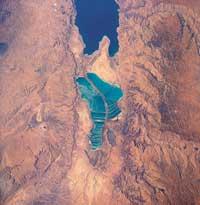
However, the lake has serious problems. The water level is constantly decreasing, because the amount of water reaching the lake has declined a lot lately. The drop in water level is due to the construction of dams in the Jordan River to respond to the water needs of the area, the agricultural use of water channels and the use of water from thermal sources to treat health problems in spas. All this without taking into account all the water demand of tourism.
This decrease in the amount of water has very serious consequences for the lake and its surroundings. Keep in mind that the stones that support the lake are very porous. Until recently these rocks have been completely hydrated, but as the water level goes down, the rocks begin to dry. Drying causes the pores to fill with air, the rocks weaken much and do not have enough strength to withstand what they have above, so the risk of sinking is increasing. According to scientists, currently the lake shore is six meters below that of the beginning of the century and the lake has already lost 30% of its surface.
In relation to this, another big problem arises: some rivers that flow into the lake, being the lower coast, have become underground rivers. The water of these rivers, towards the lake, leads with them the underground sandy matter. This has meant a strong weakening of the land surface and a risk of sinking the land adjacent to the lake.

The solution to all this is not easy. Jordan's water is necessary to supply agriculture, industry and tourism in the area, and the money obtained from the last two is a very important source for the inhabitants of the area. However, without water, only a dry lake of salt would remain. To the extent possible and if no measures are taken to solve the problem as soon as possible, what this name says of the unique environment for a long time can be true in a very short time.
Dead Sea in figures
- At -417 meters above sea level.
- Water 10 times salty than the sea: 340 g/l.
- Surface: 1,050 km 2 (55 km long, 16 km wide).
- Rain: 25-50 mm/year.
- Water volume: 128 km 3.
- Age: 12,000 years.
- Depth: 330 m.
- 200 hot springs around the lake.
- Millions of green algae and red halobacteria in the water.
- Endemic animals: - 6 sp fish - 25 amphibians sp. - 24 P mammals.
- Migratory birds: 90 sp.
- Coastal population: 30,000 people.
- Material exploited annually by industry: 2.3 million tons of industrial salt, bromine, magnesium chloride, table salt, magnesium metals.
- Production of bath salts: 2,200 tons per year.
- Water lost so far by human activities: 1/3 of the total.
- Currently only 10% of the water that arrived a century ago reaches the lake.
Health Benefits
As mentioned earlier, Cleopatra herself, and the Romans in general, already knew the health benefits of the Dead Sea. The climatic conditions of the lake seem to be especially suitable for curing superficial diseases. For example, the arrival of UV rays to the lake is much lower than to the nearby mountains.
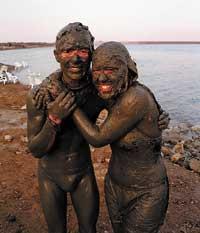
This is due to the additional 400 meters that must travel the rays before reaching the water. It seems that this extra distance makes the lower part of the atmosphere have more time to absorb UV rays. This makes there much less risk of the negative effects of UV rays and therefore burn the skin.
In addition, in the lake there are adequate concentrations of mineral salts, which seem to be very good for the surface. Magnesium, potassium, calcium, bromine and other minerals occur in high concentrations, with beneficial effects on the body.
Therefore, the low impact of UV rays, the proper concentration of minerals, the warm climate, low air pollution and the existing thermal waters make the population with health problems an ideal place. There is only the accumulation of spas, health centers and the like built around the lake.





